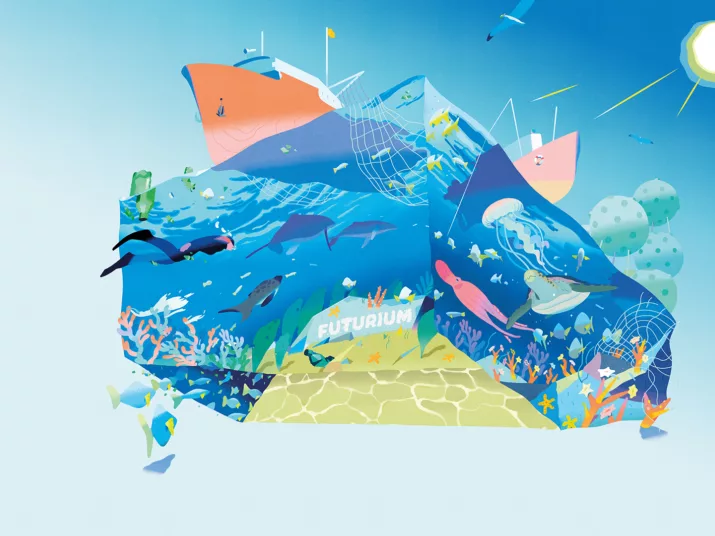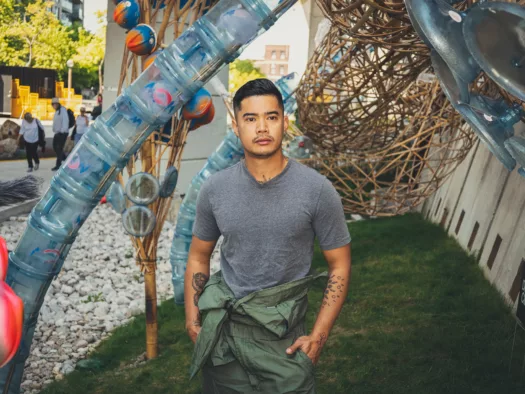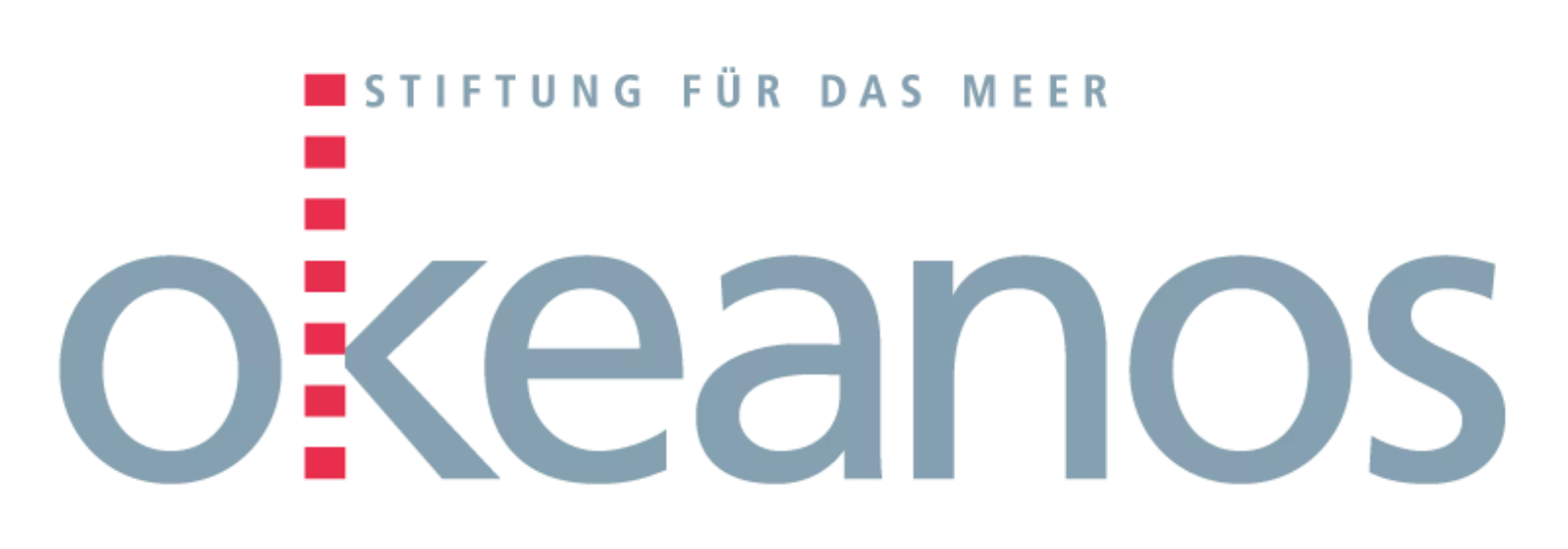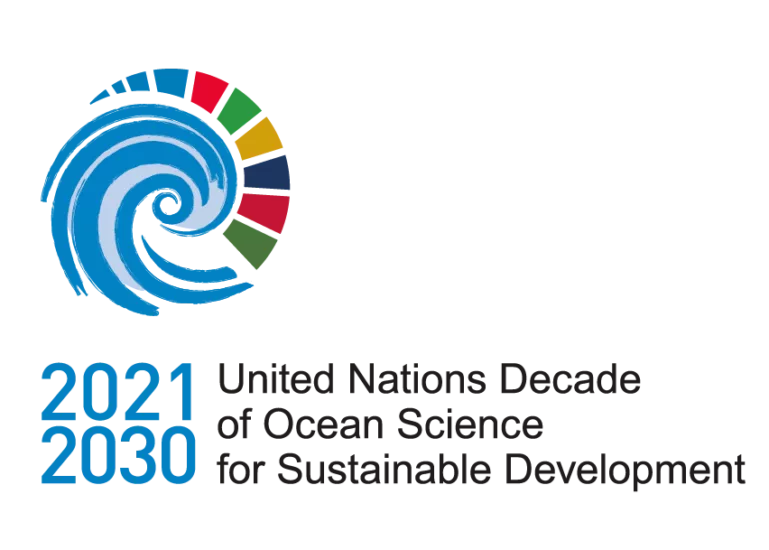
Special exhibition
Ocean Futures
What do you associate with the word “ocean”? The boundlessness of the water? Bizarre deep-sea creatures? The ideal wave for surfing? Oceans have shaped our planet for billions of years and are the basis of all life. They determine our climate, provide us with oxygen and food. And they connect us – our histories, cultures and futures. The Futurium's first special exhibition. Opening 14 November. Free admission.
Between the Baltic Sea and the Philippines
Futurium’s first special exhibition is dedicated to this body of water that spans the world. “Ocean Futures” will take you into a speculative future world on 150 square metres. The fascinating installation “Balangay Spacecraft” by Filipino artist Leeroy New – partly interwoven like a huge mangrove forest, partly unfolding like an artificial island – connects the past, present and future.
The exhibition focuses on the stories of two families of fishermen – one Filipino and one German. Their stories are about life on, and with, the sea, about hopes and worries, dreams and wishes, for the future of the oceans. Although the two families live more than 10,000 km apart, they have a lot in common.
You too can connect with the Philippines: the Mind Museum, our cooperation partner of “Ocean Futures” in the Philippines, is simultaneously showing an exhibition on the future of the oceans. During the joint opening hours, you can communicate live with visitors on the other side of the globe via the “Ocean Portal”.
Balangay Spacecraft installation
The large-scale work by Filipino artist Leeroy New transforms Futurium's first special exhibition into a speculative future world: between a fantastic mangrove landscape and an artificial island, an oceanic atmosphere unfolds that is both fascinating and unsettling.
“Balangay Spacecraft” invites you to reflect on adaptability, creativity and the use of resources. The use of recycled materials – 450 donated water canisters from Berlin businesses, collected bottles and natural materials – highlights how closely land and sea, humans and the environment are connected.
“Balangay Spacecraft” is an aesthetic space for listening, observing, learning and discussing the future of the oceans. The installation reflects the fragility of coastal areas, draws attention to climate change and the resulting rise in sea levels – and at the same time opens up a scenario of resilience and shared responsibility.
About Leeroy New
Leeroy New (*1986, General Santos City, Philippines) is a multidisciplinary artist whose practice manifests in large-scale immersive environments, costuming, collaborative performances and video works driven by concepts of world building, myth-making, and social change. His use of natural materials, found objects and assorted discards transformed into representations of a specific speculative future intersects Filipino contemporary life, pre-colonial mythology, and environmentalism. This eventually led to the creation of the Aliens of Manila project, an ongoing multi-platform collaborative series which documents “alien” bodies inhabiting Manila’s colorful yet often harsh streets as well as beyond its shores.

Leeroy New
© Leeroy New
Since 2008, New has been invited to present his unique brand of Filipino sci-fi across North America, Australia, Europe and Asia. His work has been featured at the Palais de Tokyo, Somerset House, and various international biennials and triennials, including those in Sydney, Honolulu, Busan, Fukuoka, Singapore, Setouchi, Lahore, and Ulaanbaatar. He has also been invited to design and build installations for Burning Man.
We spoke to the contemporary Filipino artist about his installation at Futurium, including the inspiration behind the title and the materials used, as well as the concept of being a citizen of the ocean. You'll find the interview here.
Audioguide
Discover our special exhibition with the free audio guide! All you need is your smartphone and a pair of headphones – then you can dive into the depths of the oceans and the stories and facts that are interwoven with them. Here you will find the audio tour for “Ocean Futures.”
Acknowledgements
We would like to thank our protagonists and exhibitors: Edgar und Sauda Casihan, Jan und Erik Meyer, Beatrice Tulagan, Jana Fahning, Kim Detloff, Leo Anthony Castro, Boris Culik, Tina Kraus, IADYS, Racing the King Tide project team (The Manila Observatory, Liverpool John Moores University, Waseda University, University of Tokyo, The Hatch), Boogs Rosales, submaris, Landesamt für Umwelt Schleswig-Holstein
We would like to thank the numerous researchers and experts from institutions in Germany and the Philippines for their expertise, including:
German Marine Research Alliance (DAM), Center for Ocean and Society, Christian-Albrecht-Universität zu Kiel, GEOMAR Helmholtz Centre for Ocean Research Kiel, Alfred Wegener Institute, Helmholtz Centre for Polar and Marine Research (AWI), Thünen Institute of Baltic Sea Fisheries, Leibniz Institute for Baltic Sea Research Warnemünde , Coastal Union Germany (EUCC-D), NABU (The Nature And Biodiversity Conservation Union), urgewald e.V., Sea Ranger e.V., Marine Science Institute, University of the Philippines, De La Salle University, Mangrove Matters PH, Center for Energy, Environment and Development
We would like to express our sincere gratitude to our shareholders for their support of our work.
We would also like to thank our partners and our sponsors:


In cooperation with

UN Decade of Ocean Science for Sustainable Development
“Ocean Futures” is part of the United Nations Decade of Ocean Science for Sustainable Development (2021–2030) – a global initiative that calls for joint efforts to create a healthy, sustainably managed ocean. The special exhibition aims to raise awareness of the need to protect the oceans as one of our central sources of life. This is achieved through intergenerational storytelling, scientific findings, artistic interventions and intercultural exchange.
